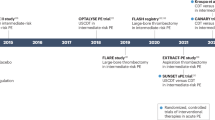Summary
An optimal therapy for pulmonary embolism (PE) was explored by comparing three different methods in order to alleviate the sufferings of PE patients and reduce the mortality. Eighty patients with PE diagnosed by computed tomography angiography (CTA) were treated with thrombolysis, anticoagulation only, or surgery/intervention. The clinical efficacy of different treatments were compared and analyzed. Twenty-four out of the 26 patients (92%) in anticoagulation only group showed improvement in CTA and clinical presentations, which was significantly higher than that in the thrombolysis group (87%, n=39, P<0.05). However, there was no significant difference in the rate of mortality between thrombolysis group and anticoagulation only group. In the surgery/interventional group (n=15), the success rate was 47%, and the mortality rate was 14%. Both of them were significantly different from those in thrombolysis and anticoagulation only groups (both P<0.05). Log-rank analysis of the data of 5-year follow-up revealed that the survival time in surgery/intervention group was significantly shorter than in the other two groups (P<0.05). It was suggested that it is of importance to choose the appropriate therapeutic regimen for PE patients. Mortality may be reduced and prognosis may be improved with anticoagulation only and thrombolysis therapy.
Similar content being viewed by others
References
Aklog L, Williams CS, Byrne JG, et al. Acute pulmonary embolectomy: a contemporary approach. Circulation, 2002,105(12):1416–1419
Wolf TR, Allen TL. Syncope as an emergency department presentation of pulmonary embolism. J Emerg Med, 1998,16(1):27–31
Kasper DL, Braunwald E, Fauci AS, et al. Pulmonary thromboembolism. Harrison’s Principles of Internal Medicine (16th ed.). New York, NY: McGraw-Hill, 2005:1561–1565
Adam T, Giancarlo A, Nicolas D, et al. Guidelines on diagnosis and management of acute pulmonary embolism. Eur Heart J, 2014,35:3033–3080
Liang Y, Yang JH, Liu S, et al. Assessment of treatment regimens in 58 cases of acute pulmonary embolism. Chin J Tuberc Respir Dis (Chinese), 2000,23(4):235–238
Mosbeck A. Diagnosis of lung embolism. Acta Med Austriaca, 1993, 200(1-2):32–35
Rahimtoola A, Bergin JD. Acute pulmonary embolism: an update on diagnosis and management. Curr Probl Cadiol, 2005,30:61–114
Anderson FA Jr, Spencer FA. Risk factors for venous thromboembolism. Circulation, 2003,207(23 suppl 1):9–16
Cheng XS. Pulmonary vascular disease (Chinese). Beijing: Joint Publishing House of Beijing Medical College and Beijing Union Medical College, 1993:179–195.
Zhang HD. Clinical treatment of pulmonary embolism. J Clin Exper Med, 2010,9(12):953–954
Gan LH, Zhang JQ, Zhang ZG, et al. Clinical analysis of surgical treatment of 54 cases of pulmonary embolism. Chin J Surg (Chinese), 2008,46(1):36–38
Wood KE. Major pulmonary embolism—review of a pathophysiologic approach to the golden hour of hemodynamically significant pulmonary embolism. Chest, 2002,121(3):877–905
Zhang ZG, Gao DF. Late progress in pulmonary embolism diagnosis. Med Recap, 2011,17(11):1684–1686
Masotti L, Righini M, Vuilleumier N, et al. Prognostic stratification of acute pulmonary embolism: focus on clinical aspects, imaging, and biomarkers. Vasc Health Risk Manag, 2009,5(4):567–575
Vedovati MC, Germini F, Agnelli G, et al. Prognostic role of embolic burden assessed at computed tomography angiography in patients with acute pulmonary embolism: systematic review and meta-analysis. Thromb Haemost, 2013,11(12):2092–2102
Gong XW, Yuan YD. Meta-analysis of risk factors for all-cause mortality of pulmonary thromboembolism. Zhonghua Yi Xue Za Zhi (Chinese), 2013,93:2534–2540
Author information
Authors and Affiliations
Corresponding author
Additional information
This project was supported by grants from the Key Project of Hubei Science and Technology Support Program, China (No. 2013BCB013), the Key Project of Hubei Natural Science Foundation of China (No. 2013CFA059), and the National Natural Science Foundation of China (No. 81270249).
Rights and permissions
About this article
Cite this article
Fan, Y., Huang, H., Xiong, J. et al. Comparison of efficacy of different treatments for pulmonary embolism. J. Huazhong Univ. Sci. Technol. [Med. Sci.] 36, 254–258 (2016). https://doi.org/10.1007/s11596-016-1576-9
Received:
Revised:
Published:
Issue Date:
DOI: https://doi.org/10.1007/s11596-016-1576-9




